Related Research Articles
Sharpe is a series of historical fiction stories by Bernard Cornwell centred on the character of British soldier Richard Sharpe. The stories formed the basis for an ITV television series featuring Sean Bean in the title role.
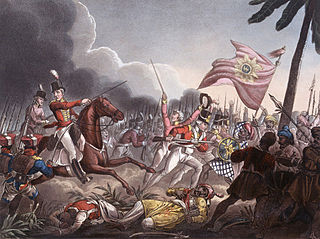
The Battle of Assaye was a major battle of the Second Anglo-Maratha War fought between the Maratha Empire and the British East India Company. It occurred on 23 September 1803 near Assaye in western India. An outnumbered Indian and British force, under the command of Major General Arthur Wellesley, defeated the combined Maratha army of Daulatrao Scindia and the Bhonsle Raja of Berar. The battle was Wellesley's first major victory and the one he later described as his finest accomplishment on the battlefield, even more so than his more famous victories in the Peninsular War, and his defeat of Napoleon Bonaparte at the Battle of Waterloo.

The Second Anglo-Maratha War (1803–1805) was the second conflict between the British East India Company and the Maratha Empire in India. It resulted in major loss of territory for the Marathas, including regions around Delhi and in present-day Gujarat falling into direct Company rule.

Gerard Lake, 1st Viscount Lake was a British general. He commanded British forces during the Irish Rebellion of 1798 and later served as Commander-in-Chief of the military in British India.
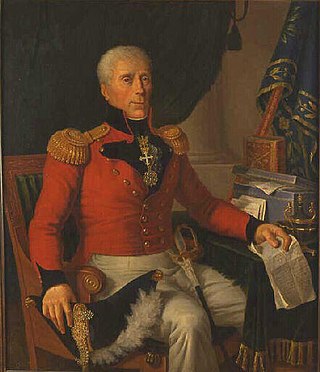
Benoît Leborgne, better known as Count Benoît de Boigne or General Count de Boigne, was a military adventurer from the Duchy of Savoy, who made his fortune and name in India with the Marathas. He was also named president of the general council of the French département of Mont-Blanc by Napoleon I.

Pierre Cuillier-Perron was a French military adventurer in active in India.
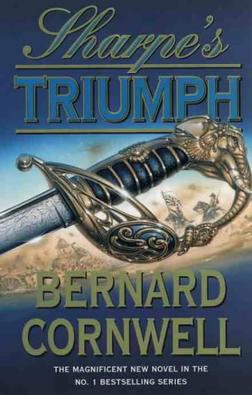
Sharpe's Triumph is the second historical novel in the Richard Sharpe series by Bernard Cornwell, first published in 1998. Sharpe is a sergeant in the army who attracts the attention of General Arthur Wellesley at Ahmednagar.

Gwalior state was a semi-autonomous Maratha state. It was centred in modern-day Madhya Pradesh, arising due to the rise of the Maratha Empire and fragmentation of the Mughal Empire.

Shrimant Daulat Rao Shinde was the Maharaja (ruler) of Gwalior state in central India from 1794 until his death in 1827. His reign coincided with struggles for supremacy within the Maratha Empire, and wars with the expanding East India Company. Daulatrao played a significant role in the Second and Third Anglo-Maratha wars.

The Battle of Khadki, also known as or the Battle of Ganeshkhind and Battle of Kirkee took place at modern day Khadki, India, on 5 November 1817 between the forces of the British East India Company and the Maratha Empire under the leadership of Appasaheb Bhonsle. Company forces achieved a decisive victory, with Khadki later becoming a military cantonment under British rule.
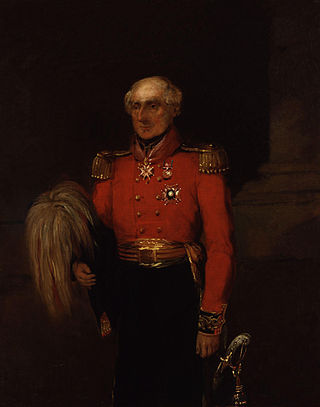
Lieutenant-General Sir Colin Campbell was a British Army officer and colonial governor.
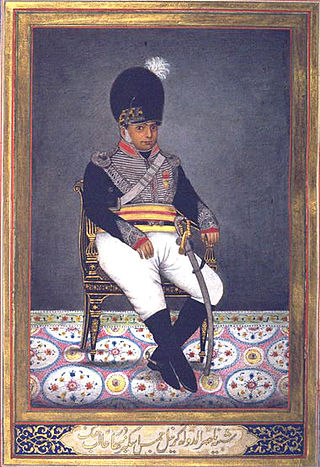
Colonel James Skinner was an Anglo-Indian military adventurer and soldier of the East India Company of British India. Prior to this he also served briefly as a mercenary in the Maratha Army. He became known as Sikandar Sahib later in life and is most known for two cavalry regiments he raised for the British at Hansi in 1803, known as 1st Skinner's Horse and 3rd Skinner's Horse, which are still units of the Indian Army.

Yashwant Rao Holkar also known as Jaswantrao Holkar belonging to the Holkar dynasty of the Maratha Confederacy was the Maharaja of the Indore. He was a gifted military leader and educated in accountancy as well as literate in Persian and Marathi and Urdu.
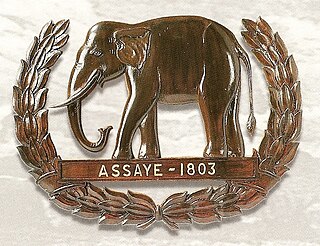
The Assaye battle honour was awarded by the Governor General of British India to all East India Company battalions and British Army regiments that took part of the Battle of Assaye. The battle occurred on 23 September 1803, near the village of Assaye in western India where a small force under the command of Major General Arthur Wellesley defeated a 50,000 strong army of the Maratha Confederacy. The British and native troops were awarded the battle honour Assaye with the device of Elephant vide General Order of Governor General dated 30 October 1803. The British regiments and Madras battalions involved were also presented with an honorary colour to mark their achievement. The Madras Battalions celebrated the victory for over a century till their disbandment in the 1920s.

The 62nd Punjabis was an infantry regiment of the British Indian Army. It was raised in 1759 as the 3rd Battalion of Coast Sepoys, and formed part of the Madras Army. It was designated as the 62nd Punjabis in 1903 and became 1st Battalion 1st Punjab Regiment in 1922. In 1947, it was allocated to the Pakistan Army, where it continues to exist as 1st battalion, Punjab Regiment. It is the senior-most surviving infantry battalion of the British Indian Army.

Lieutenant General Sir Jasper Nicolls KCB was Commander-in-Chief, India.

The Maratha Army was the land-based armed forces of the Maratha Empire, which existed from the late 17th to the early 19th centuries in the Indian subcontinent
Charles Best was a British army officer of Hanoverian descent who served in the armies of the East India Company, Britain and Hanover from 1781 until the end of the Napoleonic Wars.
Major General Nicholas Carnegie of Coates HEIC (1750–1824) was an 18/19th century British Army Officer
References
- 1 2 Millar, Simon (2006). Assaye 1803: Wellington's First and 'Bloodiest' Victory . Oxford: Osprey Publishing. pp. 16–17. ISBN 1-84603-001-3.
- ↑ Compton, Herbert (1892). A particular account of the European military adventures of Hindustan, from 1784 to 1803. London: T. Fisher Unwin. pp. 381–382.